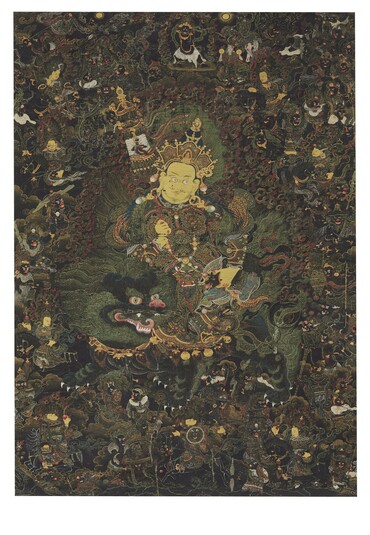
Item: Vaishravana (Buddhist Protector) - Riding a Lion
| Origin Location | Tibet |
|---|---|
| Lineages | Buddhist |
| Material | Ground Mineral Pigment, Black Background on Cotton |
| Collection | Private |
Classification: Deity
Appearance: King
Gender: Male
Vaishravana Riding a Lion (Tibetan: nam to se. English: the Son of Namto): Guardian King, God of the Northern Direction.
Vaishravana Riding a Lion is a worldly Buddhist protector. There are a number of different forms of Vaishravana seated atop a lion. With this particular iconographic form it is Vaishravana and the Eight Horsemen that is referred to here. This image with the Eight Horsemen is the most common form found in art after the earliest Vaishravana form. The earliest form of Vaishravana has no lion. He is either a seated or standing figure found at the entrance way to temples or monasteries, and included in images, both painted and sculpture, of Shakyamuni Buddha and the Sixteen Arhats.
"With vajra armor, a garland of jewel ornaments and the beautiful heavenly banner - fluttering, illuminated in the middle of a hundred thousand Wealth Bestowers; homage to Vaishravana, chief among the protectors of the Teaching." (Nyingma liturgical verse).
Vaishravana, leader of the Yaksha race, is a worldly guardian worshipped as both a protector and benefactor. He, with his wife - a naga princess, lives on the north side of the lower slopes of mount Meru in the Heaven of the Four Great Kings in a sumptuous palace bathed in green emerald light. As the leader of the Four Direction Guardians, he at the head of the others, swore an oath of protection before the Buddha Shakyamuni. The stories and iconography of the Four Guardians arise primarily from the Mahayana Sutras and are common to all schools of Tibetan Buddhism. Lord Atisha popularized the meditation practice of Vaishravana in the 11th century.
The stories and iconography of the Four Guardian Kings arise primarily from the Mahayana sutras and are common to all schools of Tibetan Buddhism. A distinction must be made between the various narratives of Vaishravana depending on the Sutra and Tantra literature.
Inscriptions on the reverse of the painting:
The central two lines at the back of the painting are the 'Ye Dharma' prayer. There are no donor names or dates. It concludes with a short mantra and then the phrase 'sarva mangalam.'
The inscription on at the top center reads, in the three vertical syllables: om, ah, hum, representing the vajra body, speech, and mind. The horizontal inscription immediately below reads Om vajrapani hum, and is the mantra for the deity Vajrapani depicted at the top center on front of the painting.
The remaining eight inscription locations on the reverse of the painting follow the same inscription model as Vajrapani with the om, ah, hum syllables written vertically and then the name mantra for each of the eight attendant/retinue horsemen for the central figure of the composition Vaishravana Riding a Lion.
The script is called Vartu and is a variation of Lantsa script: http://www.lantsha-vartu.org/vartuscript/index.html
Jeff Watt 3-2013
Buddhist Deity: Vaishravana Riding a Lion (Masterworks)
Buddhist Worldly Protector: Vaishravana Riding a Lion
Painting Type: Black Ground Main Page
Collection: Christie's, Jan. 28, 2014
Buddhist Worldly Protector: Vaishravana (Painting Masterworks)



